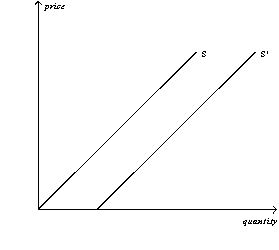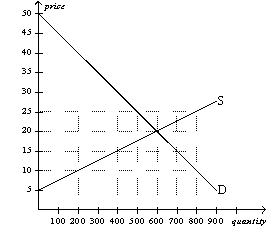A) 500 units and 500 units.
B) 500 units and 800 units.
C) 600 units and 600 units.
D) 800 units and 500 units.
F) B) and D)
Correct Answer

verified
Correct Answer
verified
Multiple Choice
A surplus exists in a market if
A) there is an excess demand for the good.
B) quantity demanded exceeds quantity supplied.
C) the current price is above its equilibrium price.
D) All of the above are correct.
F) None of the above
Correct Answer

verified
Correct Answer
verified
True/False
The quantity supplied of a good or service is the amount that sellers are willing and able to sell at a particular price.
B) False
Correct Answer

verified
Correct Answer
verified
Multiple Choice
Assume the market for tennis balls is perfectly competitive.When one tennis ball producer exits the market,
A) the price of tennis balls increases.
B) the price of tennis balls decreases.
C) the price of tennis balls does not change.
D) there is no longer a market for tennis balls.
F) B) and C)
Correct Answer

verified
Correct Answer
verified
Multiple Choice
Another term for equilibrium price is
A) dynamic price.
B) market-clearing price.
C) quantity-defining price.
D) balance price.
F) B) and C)
Correct Answer

verified
Correct Answer
verified
Multiple Choice
Which of the following events would unambiguously cause a decrease in the equilibrium price of cotton shirts?
A) an increase in the price of wool shirts and a decrease in the price of raw cotton
B) a decrease in the price of wool shirts and a decrease in the price of raw cotton
C) an increase in the price of wool shirts and an increase in the price of raw cotton
D) a decrease in the price of wool shirts and an increase in the price of raw cotton
F) None of the above
Correct Answer

verified
Correct Answer
verified
Multiple Choice
A decrease in the number of sellers in the market causes
A) the supply curve to shift to the left.
B) the supply curve to shift to the right.
C) a movement up and to the right along a stationary supply curve.
D) a movement downward and to the left along a stationary supply curve.
F) None of the above
Correct Answer

verified
Correct Answer
verified
Multiple Choice
Figure 4-13  -Refer to Figure 4-13.If the supply curves that are drawn represent supply curves for single-family residential houses,then the movement from S to S' could be caused by a(n)
-Refer to Figure 4-13.If the supply curves that are drawn represent supply curves for single-family residential houses,then the movement from S to S' could be caused by a(n)
A) increase in the price of apartments which are a substitute for single-family houses for many people looking for a place to live.
B) newly-formed expectation by house-builders that prices of houses will increase significantly in the next six months.
C) decrease in the price of lumber.
D) All of the above are correct.
F) B) and D)
Correct Answer

verified
Correct Answer
verified
Multiple Choice
Table 4-6
 -Refer to Table 4-6.Which combination would produce a decrease in equilibrium quantity and an indeterminate change in equilibrium price?
-Refer to Table 4-6.Which combination would produce a decrease in equilibrium quantity and an indeterminate change in equilibrium price?
A) A
B) B
C) C
D) D
F) A) and D)
Correct Answer

verified
Correct Answer
verified
Multiple Choice
In competitive markets,which of the following is not correct?
A) Firms produce identical products.
B) No individual buyer can influence the market price.
C) Some sellers can set prices.
D) Buyers are price takers.
F) A) and C)
Correct Answer

verified
Correct Answer
verified
Multiple Choice
For the general population,a 10 percent increase in the price of cigarettes leads to a
A) 1 percent reduction in the quantity demanded of cigarettes.
B) 4 percent reduction in the quantity demanded of cigarettes.
C) 10 percent reduction in the quantity demanded of cigarettes.
D) 12 percent reduction in the quantity demanded of cigarettes.
F) C) and D)
Correct Answer

verified
Correct Answer
verified
True/False
When the price of a good is low,selling the good is profitable,and so the quantity supplied is large.
B) False
Correct Answer

verified
Correct Answer
verified
True/False
The market demand curve shows how the total quantity demanded of a good varies as the income of buyers varies,while all the other factors that affect how much consumers want to buy are held constant.
B) False
Correct Answer

verified
Correct Answer
verified
Multiple Choice
When quantity demanded has increased at every price,it might be because
A) the number of buyers in the market has decreased.
B) income has increased,and the good is an inferior good.
C) the costs incurred by sellers producing the good have decreased.
D) the price of a complementary good has decreased.
F) B) and C)
Correct Answer

verified
Correct Answer
verified
Multiple Choice
A competitive market is a market in which
A) an auctioneer helps set prices and arrange sales.
B) there are only a few sellers.
C) the forces of supply and demand do not apply.
D) no individual buyer or seller has any significant impact on the market price.
F) A) and C)
Correct Answer

verified
Correct Answer
verified
Multiple Choice
Table 4-4
 -Refer to Table 4-4.If these are the only four sellers in the market,then the market quantity supplied at a price of $10 is
-Refer to Table 4-4.If these are the only four sellers in the market,then the market quantity supplied at a price of $10 is
A) 3 units.
B) 11 units.
C) 25 units.
D) 44 units.
F) C) and D)
Correct Answer

verified
Correct Answer
verified
Multiple Choice
Figure 4-17  -Refer to Figure 4-17.If the price is $10,then there would be a
-Refer to Figure 4-17.If the price is $10,then there would be a
A) shortage of 400 units,and price would rise.
B) surplus of 400 units,and price would rise.
C) shortage of 600 units,and price would rise.
D) surplus of 600 units,and price would rise.
F) C) and D)
Correct Answer

verified
Correct Answer
verified
Multiple Choice
A shortage exists in a market if
A) there is an excess supply of the good.
B) quantity supplied exceeds quantity demanded.
C) the current price is below its equilibrium price.
D) All of the above are correct.
F) None of the above
Correct Answer

verified
Correct Answer
verified
True/False
If a determinant of demand other than price changes,the demand curve shifts.
B) False
Correct Answer

verified
Correct Answer
verified
Multiple Choice
In markets,prices move toward equilibrium because of
A) the actions of buyers and sellers.
B) government regulations placed on market participants.
C) increased competition among sellers.
D) buyers' ability to affect market outcomes.
F) All of the above
Correct Answer

verified
Correct Answer
verified
Showing 161 - 180 of 567
Related Exams